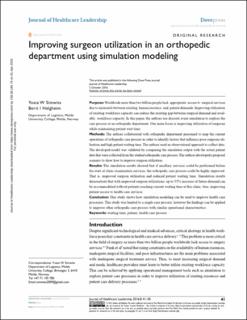| dc.contributor.author | Simwita, Yusta Wilson | |
| dc.contributor.author | Helgheim, Berit Irene | |
| dc.date.accessioned | 2023-02-21T16:55:35Z | |
| dc.date.available | 2023-02-21T16:55:35Z | |
| dc.date.created | 2016-11-10T12:20:31Z | |
| dc.date.issued | 2016 | |
| dc.identifier.citation | Journal of Healthcare Leadership. 2016, 8, 41-50. | en_US |
| dc.identifier.issn | 1179-3201 | |
| dc.identifier.uri | https://hdl.handle.net/11250/3052901 | |
| dc.description.abstract | Purpose: Worldwide more than two billion people lack appropriate access to surgical services due to mismatch between existing human resource and patient demands. Improving utilization of existing workforce capacity can reduce the existing gap between surgical demand and available workforce capacity. In this paper, the authors use discrete event simulation to explore the care process at an orthopedic department. Our main focus is improving utilization of surgeons while minimizing patient wait time. Methods: The authors collaborated with orthopedic department personnel to map the current operations of orthopedic care process in order to identify factors that influence poor surgeons utilization and high patient waiting time. The authors used an observational approach to collect data. The developed model was validated by comparing the simulation output with the actual patient data that were collected from the studied orthopedic care process. The authors developed a proposal scenario to show how to improve surgeon utilization. Results: The simulation results showed that if ancillary services could be performed before the start of clinic examination services, the orthopedic care process could be highly improved. That is, improved surgeon utilization and reduced patient waiting time. Simulation results demonstrate that with improved surgeon utilizations, up to 55% increase of future demand can be accommodated without patients reaching current waiting time at this clinic, thus, improving patient access to health care services. Conclusion: This study shows how simulation modeling can be used to improve health care processes. This study was limited to a single care process; however the findings can be applied to improve other orthopedic care process with similar operational characteristics. Keywords: waiting time, patient, health care process | en_US |
| dc.language.iso | eng | en_US |
| dc.rights | Navngivelse 4.0 Internasjonal | * |
| dc.rights.uri | http://creativecommons.org/licenses/by/4.0/deed.no | * |
| dc.title | Improving surgeon utilization in an orthopedic department using simulation modeling | en_US |
| dc.type | Peer reviewed | en_US |
| dc.type | Journal article | en_US |
| dc.description.version | publishedVersion | en_US |
| dc.source.pagenumber | 41-50 | en_US |
| dc.source.volume | 8 | en_US |
| dc.source.journal | Journal of Healthcare Leadership | en_US |
| dc.identifier.doi | 10.2147/JHL.S112856 | |
| dc.identifier.cristin | 1399094 | |
| cristin.ispublished | true | |
| cristin.fulltext | original | |
| cristin.qualitycode | 1 | |

